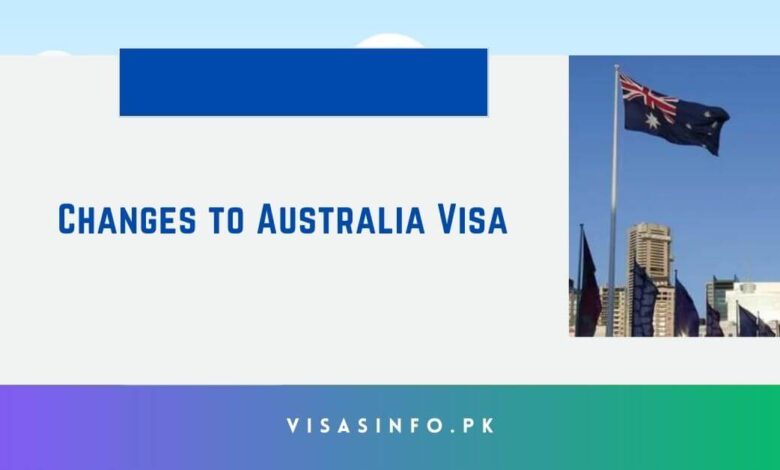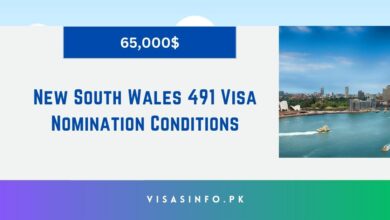Changes to Australia Visa 2024 – Visit Here

In this update, we will discuss the immigration situation in Australia in 2024. Beginning in January 2024, the Australian government will implement numerous substantial modifications to its immigration laws. These are intended to facilitate the processing of work permits and stimulate regional economies. The primary modifications that you should anticipate are summarized below.
1. Introduction of Pacific Engagement Visa
The Australian government intends to implement the Pacific Engagement Visa (PAV) on January 1, 2024. The PAV endeavors to recruit qualified personnel from the Pacific Islands nations. Qualified Australians will be granted 3,000 permanent residency spaces annually through this transitory visa. Individuals from the Pacific Islands
2. Eliminating the Age Limit for the Working Holiday Visa Extension
As of January 31, 2024, the age limit for applicants from qualifying countries seeking a Working Holiday Visa (Subclass 462) has been increased to 35 years. This is by the Free Trade Agreement between the United Kingdom and Australia.
3. Deletion of the 2-Year Age Exemption for Skilled Regional Visas
The two-year age exemption period for petitioners of Regional Skilled Visas (Subclass 491) will also expire on July 1, 2024. At the time of invitation, all applicants for this visa must be under the age of 45.
4. Regional Visas for Applicants with High Income
The government will increase the number of regional visas available to candidates with high incomes starting on July 1, 2024. This is one of the strategies employed by the government to attract highly qualified professionals to the neighboring regions.
5. Amendments Relating to Skilled Migration Occupation Lists
In 2024, the Australian government intends to revise and revise its listings of skilled migration occupations. The evaluation procedure will guarantee that the lists are consistent with the current industry requirements. This is a continuation of the Australian government’s ongoing endeavors to modernize immigration laws to augment the nation’s labor force, talent pool, and abilities.
8 Australia Visa and Immigration Updates
Several visa categories were significantly impacted by significant revisions to Australian immigration law. This update will provide a comprehensive examination of the eight primary modifications that will impact visas from September.
1. ACT Invitation Round – November
The ACT held its invitation round on November 27, 2023, during which Canberrans were invited to submit recommendations for small business proprietors, 457 and 482 Visa holders, critical skill professionals, and foreign candidates for critical skill occupations. The subsequent round will occur before February 5, 2024.
2. New South Wales Enhanced Pathways for Nominations
In addition to modernizing the procedures for the Skilled Work Regional Visa under the two primary Pathways of invitation by investment (Pathway 2) and direct application (Pathway 1), New South Wales has established more effective and open avenues for nominations. The government plans to distribute invitations for Pathway 2 immediately after it commences accepting direct applications under Pathway 1.
3. Tasmania Nomination and Processing Time
Invitations are issued to approximately thirty individuals each week in Tasmania following interest registrations. However, only the most exceptional candidates are selected for nomination. The skilled regional work visa has been authorized for 206 nominations, while 286 of the 600 seats allocated for the skilled nomination visa have been filled.
4. 11 New Occupations Added by Northern Territory DAMA
The Northern Territory DAMA has been extended for an additional year, until December 24, 2024, as a result of the inclusion of 11 new occupations. This implies that a total of 135 occupations are currently eligible. After working in a full-time capacity in the Northern Territory for two years, foreign laborers may be nominated for permanent Subclass 186 visas. The salary requirement for transitory skilled migration has been reduced to $55,000 for a variety of occupations.
5. Nominations for Skilled Work Regional Subclass 490 Visa
The Northern Territory government has disclosed information regarding nominations and applications for the Regional Subclass 490 Visa for skilled employment for the 2023–2024 year, which commenced on October 23, 2023. Among the modifications that candidates must be aware of are the work requirement for Northern Territory residents, the exclusion of Northern Territory graduates, and the Limited offshore priority occupation stream.
6. South Australia Skilled Migration Program
The 2023–2024 Skilled Migration State Nomination program in South Australia has undergone numerous enhancements from the previous fiscal year. In addition to the limited number of nominations available, South Australia Migration has implemented a Registration of Interest mechanism to efficiently manage the overwhelming volume of applications. One area that necessitates special attention is the prioritization of the retention of international graduates and individuals in South Australia on temporary visas.
7. New South Wales Focus on Priority Sectors
New South Wales will prioritize Priority Industries on lists of skilled employment under the financial year 2024. The focus of New South Wales will be on the following sector groupings: agriculture, infrastructure, health, education, and information and communication technology (ICT). Despite the Australian government’s intention to prioritize key industries, high-ranking EOIs submitted in non-priority industries may also be considered based on the demand for labor.
Check Also: Australia Upcoming Visa Changes for
8. New Australia PR Pathway for 457 and 482 Visa Holders
This update encompasses the primary amendments to the immigration legislation, as well as the fourth report for November, which pertains to the most recent developments in Australian immigration law. The 1994 Migration Law, which was implemented on November 25, 2023, is currently undergoing substantial modifications by the Australian government. Individuals who possess Subclass 457 and Subclass 482 visas ought to prioritize these developments.
Benefits of Changes to Australia Visa
- Skilled Migration: The General Skilled Migration program has undergone modifications that have benefited skilled workers by providing them with more direct pathways to permanent residency, such as updates to the points-based system. Among the modifications are the addition of additional points for regional work experience and talents that are in high demand.
- Visa limit Increases: Australia has increased the limit on specific visa categories, thereby enabling a greater number of individuals to qualify for permanent residency, particularly in the skilled worker streams. This reduces competition for visa spaces, which is advantageous for applicants.
- International students: are now granted extended work privileges, which include the ability to work additional hours while studying and to remain in the country for an extended period after graduation. These modifications render Australia a more appealing destination for international education and offer improved employment opportunities following the completion of the program.
- Temporary Workers’ Pathways: In Australia, temporary workers, particularly those employed in critical sectors such as agriculture and health, have been granted more accessible pathways to permanent residency, which provides them with increased job security and settlement opportunities.
- Regional Visa Incentives: Individuals who choose to reside and work in regional Australia are granted more considerable assistance and more expedited pathways to permanent residency. This promotes the migration of workers to regions that necessitate a larger workforce and provides new job opportunities.
- Visa Fee Reductions and Processing Times: The application process has been made more affordable and less time-consuming for applicants, resulting in quicker decisions. This has been achieved through streamlined visa processing and reductions in fees for specific visas.
- Modifications to Family and Humanitarian Visas: The implementation of new regulations regarding family reunification and humanitarian visas facilitates the reunion of families and the establishment of refugee protection in Australia.
Frequently Asked Questions:
-
What is the new visa rule in Australia?
Effective 1 July 2024, visa conditions 8107, 8607, and 8608 will allow 482 visa holders up to 180 days at a time (365 days total) to find a new sponsor, apply for a different visa, or arrange to depart Australia. During this time, they will be able to work for other employers.
-
What is the quickest way to migrate to Australia?
Pros: The Skilled Worker Visa is one of the easiest ways to immigrate to Australia because it is based on a points system that gives weight to factors such as age and work experience. This means that if you meet the requirements, then you can easily apply for the visa without the need for a sponsor or employer.
-
Which Australian visa is free?
For the eVisitor visa, there is no application or service fee.



